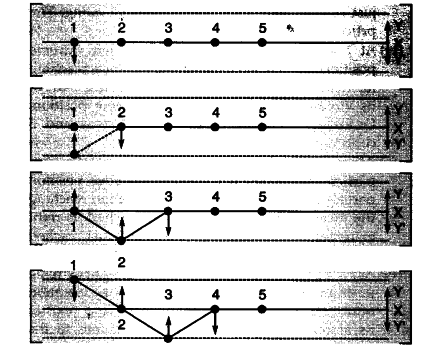A transverse wave motion is that motion in which individual particle of the medium execute simple harmonic motion about their mean position in a direction perpendicular to the direction of propagation of wave.
Examples : (i) Movement of string of a sitar or a violin.
(ii) Movement of a kink on a rope.
A transverse wave travel through a medium in the form of crests and troughs.
Propagation of transverse waves : Let us consider a series of 5 equally spaced particles 1,2,3,4,5 in a straight line. When these particles execute S.H.M. of equal amplitudes and time period about their mean positions in the upward and downward directions. Solid lines represent the mean positions and dotted lines up and down represents the extreme positions, while vibrating xy = x)/ is the amplitude of vibration. Let T is the time period of vibration of each particle, and the disturbance is handed on from one particle to the adjoining particle, and the disturbance is handed on from one particle to the adjoining particle in T/4 sec.

(i) At t = 0, all the particles 1,2,3,4,5 are at rest at their
means positions and the disturbance just reaches particle 1 which start moving downwards. The other particles 2,3,4 and 5 are at rest.
(ii) At t = T/4, particle 1 completes 1/4th of its vibration
and reaches the lower extreme positions, the disturbance just reaches particle 2, which starts vibrating downwards. The particles 3, 4, 5 are at rest.
(iii) At t = T/2, particle 1 completes 1/2 of its vibration reaching the mean position, particle 2 reaches its
lower extreme position and disturbance just reaches particle 3, which starts vibrating. The particles 4 and 5 are at rest. Vi
(iv) At t = 3T/4, particle 1 goes to its upper extreme
position, particle 2 has completed half its vibration reaching its mean position, particle 3 has executed, 1/4th of its vibration, reaching its lower extreme position. Disturbance has just reached particle 4 and 5 continues to be at rest.
(v) At t = T, particle 1 has completed one vibration,
particle 2 has reached its upper position, particle 3 has completed half of its vibration reaching the mean position and disturbance has just reached particle 5